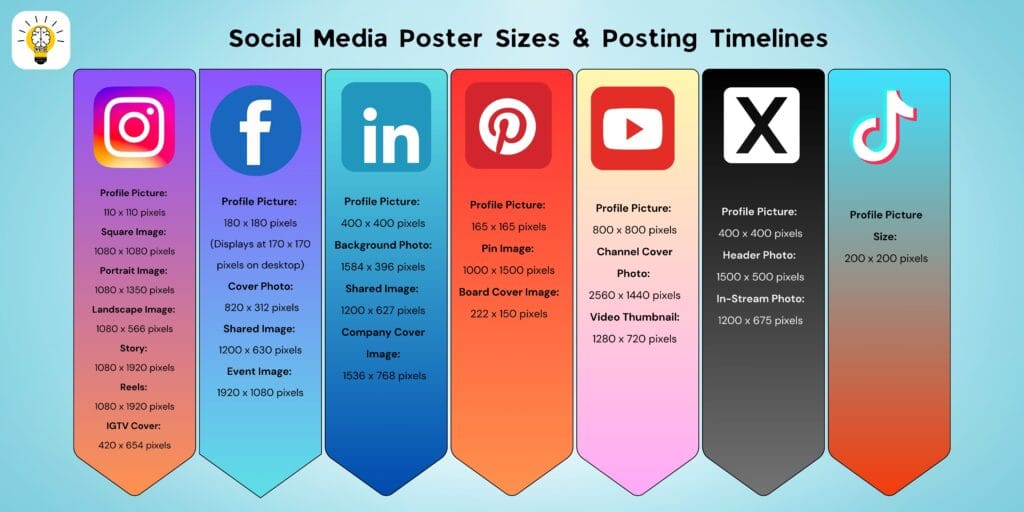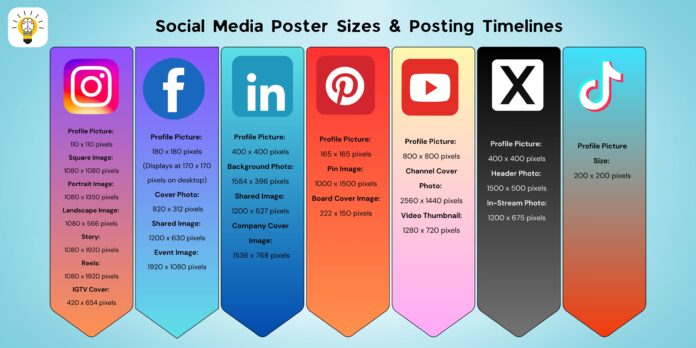Introduction to Social Media Poster Sizes, Formats & Timelines
Social media posters are becoming an important part of online marketing campaigns in the age of digital media, where visual content is king. They are more than just beautiful images; they are powerful tools that boost traffic, engagement, and brand building. Knowing the minute details of social media poster sizes, formats, and ideal publishing dates can be helpful for marketers of all experience levels. Let’s explore this comprehensive approach to make sure your social media images are always current.
Table of Contents

Understanding Social Media Poster Sizes
Profile Picture: 180×180 pixels
Cover Photo: 820×312 pixels
Post Image: 1200×630 pixels
Facebook is an adaptable platform where different visual components need to be paid attention to. Frequently, your profile photo is the first thing people see, so make a good one. Your profile’s cover picture shows your company. A landscape format is ideal for posting photos in order to guarantee clarity and engagement.
Profile Picture: 110×110 pixels
Feed Post: 1080×1080 pixels (square), 1080×1350 pixels (portrait), 1080×566 pixels (landscape)
Story: 1080×1920 pixels
The focus of Instagram is on beautiful images. While feed posts are often displayed in square format, feel free to experiment with portrait and landscape configurations. Use the entire vertical area to your advantage when sharing stories—they’re an ideal way to distribute fleeting content.
Profile Picture: 400×400 pixels
Header Image: 1500×500 pixels
In-Stream Photo: 1600×900 pixels
In the quick-paced world of Twitter, captivating pictures are important. Your header image and profile photo should be well-thought-out and professionally produced. High-resolution images for in-stream content—which show up in the feeds of your followers—should make them stand out from the rest of the pack.
Profile Picture: 400×400 pixels
Cover Image: 1584×396 pixels
Shared Image: 1200×627 pixels
Because LinkedIn is the social networking hub for professionals, your images should be professional and suitable for a business setting. A headshot should be your profile picture, and a professional and credible image should be your cover photo. Your posts and articles should be supported by the shared photographs you use.
Profile Picture: 165×165 pixels
Pin Image: 1000×1500 pixels
The quality of your pins on Pinterest, a visually-driven network, can make or break the way you approach it. To get the most engagement, make sure your pin photos are vertically set up and your profile picture is clear.
TikTok
Profile Picture: 200×200 pixels
Video Thumbnail: 1080×1920 pixels
Given the dynamic nature of TikTok, your images must be lively and captivating. Your video thumbnails should inspire people to see your material, and your profile photo should be instantly identifiable.
Best Practices for Social Media Poster Formats
Image Formats: JPEG, PNG, GIF
As a result of their compression capacity, JPEGs work well for images, whereas PNGs are ideal for graphics that need to be transparent and have fine details. GIFs can give your content a playful, dynamic touch, but use them carefully to avoid clutter.
Video Formats: MP4, MOV
With an acceptable compromise between file size and quality, MP4 is the most widely used format. MOV files can be larger in size yet have excellent quality, which makes them appropriate for high-definition content.
Resolution and Quality Considerations
To prevent pixelation and preserve a polished appearance, always strive for high-resolution photos and movies. High-quality material is especially helpful on visually-focused platforms like Pinterest and Instagram.
Optimal Posting Timelines for Maximum Engagement
Best times: Wednesday, from 11 a.m. to 1 p.m.
Worst times: Weekends and evenings
Best times: Wednesday at 11 AM and Friday from 10-11 AM
Worst times: Late nights
Best times: At 9:00 in the morning on Wednesday and Friday.
Worst times: Late nights and weekends
The best times: is Wednesday at noon and 8–10 AM.
Worst times: Weekends and evenings
Best times: Saturday evening
Worst times: Working hours during weekdays
TikTok
Best times: Tuesday and Thursday from 9-11 AM
Worst times: Late nights
Tips for Designing Effective Social Media Posters
Choosing the Right Colors
Emotions are stirred up by color, and color can greatly influence participation. Select hues that suit your brand and will captivate your target market. You may make color schemes that are harmonious by using programs like Adobe Color.
Using Text and Typography
Write brief, powerful text. Make sure your message is readily apparent by using bold and readable fonts. Keep your poster simple and let the images do the talking. Keep the text the same.
Incorporating Brand Elements
To keep your social media accounts consistent, use your logo, brand colors, and other branding elements. This promotes trust and brand familiarity.
Balancing Visuals and Information
Achieve balance between information and images. If you go overboard with it as well, your audience will become overwhelmed. Make good use of white space to produce a simple, eye-catching design.
Tools and Resources for Creating Social Media Posters
Design Software
Canva: is user-friendly and packed with templates.
Adobe Spark: is great for creating professional designs quickly.
Stock Image Websites
Unsplash: Offers high-quality, free images.
Pexels: One more great place to get free stock images.
Online Templates and Mockups
Websites like GraphicRiver and Creative Market offer templates and mockups that can save you time and provide inspiration for your designs.

Conclusion
Understanding the specific demands of each platform—from sizes and layouts to the ideal times to post—is essential to creating social media posters that are effective. You may improve your social media presence and audience participation by adhering to the rules and advice in this guide. To keep your material relevant and impactful, always remember to try new things, adjust, and keep up with the newest trends.
FAQs
What are the most common social media poster sizes?
The most common sizes vary by platform, but generally, Facebook post images are 1200×630 pixels, Instagram feed posts are 1080×1080 pixels, and Twitter in-stream photos are 1600×900 pixels.
How can I ensure my images look good on all platforms?
Use high-resolution images and follow each platform’s recommended sizes and formats. Tools like Canva can help resize images correctly.
What are some free tools for creating social media posters?
Canva and Adobe Spark are popular free tools that offer a wide range of templates and design elements.
How often should I update my social media posters?
It depends on your content strategy, but generally, updating your visuals every few months or with each new campaign is a good practice.
Can I use the same poster for all social media platforms?
While you can use the same design, it’s important to resize and format it according to each platform’s specifications to ensure optimal display and engagement.

